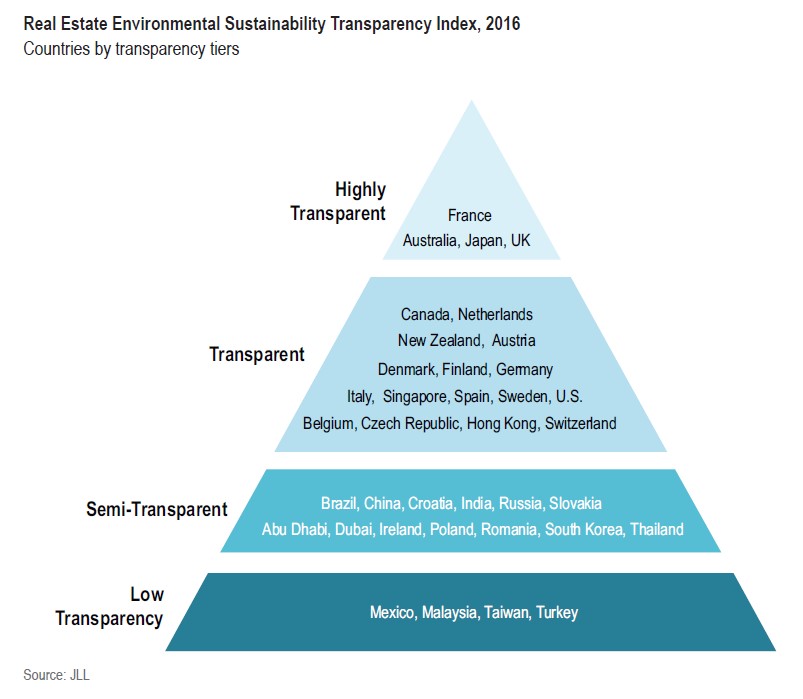by Brianna Crandall — November 7, 2016 — Global professional real estate services and investment management firm JLL (Jones Lang LaSalle) recently released its 2016 Real Estate Environmental Sustainability Index, part of the firm’s ninth Global Real Estate Transparency Index, which covers 109 markets worldwide, and shows continued progress in the transparency of commercial real estate around the world.
According to the Transparency Index, two-thirds of markets have registered overall improvement since 2014. Improvement is generally correlated with higher foreign direct investment and corporate occupier activity, as investors and corporations help to accelerate transparency reforms and governments recognize that poor transparency will affect continued inward investment, long-term economic growth prospects and the quality of life of citizens, notes JLL.
The Real Estate Environmental Sustainability Index (see lower half of page) analyzes 37 markets that represent 97 percent of global direct commercial real estate investment volumes in 2015. The Sustainability Index tracks the following measures:
- Carbon reporting
- Energy consumption benchmarking
- Financial performance
- Green building certification
- Green lease clauses
- Minimum energy standards (existing buildings)
- Minimum energy building standards (new build)
Real Estate Environmental Sustainability Index global results
France has topped JLL’s Real Estate Environmental Sustainability Index for the first time, thanks to the consistent roll-out of legislated mandates to transition to a low-carbon economy. Japan has moved up from the transparent group to join France, Australia and the U.K. in the highly transparent group, thanks to the introduction of several new sustainability tools.

Two-thirds of markets show overall improvement in real estate environmental sustainability transparency since 2014, correlated with higher foreign direct investment and corporate occupier activity.
Another leadership example is shown by Dubai, which has moved into the semi-transparent group for the first time, thanks to the introduction of mandatory green building specifications for new constructions of residential, commercial and public buildings in the Emirate.
While 17 of the 37 countries tracked have improved their overall scores since the last survey two years ago, 13 have remained static, and three have declined. Half of all country index improvements have been driven by the introduction of voluntary minimum energy efficiency standards for existing buildings.
Franz Jenowein, director and head of Global Sustainability Research at JLL commented:
Environmental performance considerations are becoming more widely established across global markets, but the pace of progress in creating new tools and regulations is slow. Clearly defined carbon reporting frameworks and obligations for companies are missing in too many countries. It can only be hoped that the success of the Paris Agreement on climate change, last December in Paris, will stimulate a wider introduction of standardized carbon reporting instruments.
Voluntary instruments complementing compliance-driven tools have an important role to push real estate portfolio transparency to the next level, points out the report. The most widely used investor portfolio benchmarking tool across a wide variety of variables, the Global Real Estate Sustainability Benchmark (GRESB), now covers 61,000 assets worldwide, a positive year-on-year increase of nine percent.
Other key country movers:
- Finland, one of the four new entrants along with Malaysia, Taiwan and Thailand, has gone straight into the “transparent” tier and is now alongside more advanced markets such as Singapore and Germany.
- The USA and Switzerland have moved from the semi-transparent group into transparent.
- Slovakia, Romania and South Korea have moved from low transparency up to semi-transparent.
Key highlights in sustainability measures:
- The most ubiquitous environmental transparency instruments, and cornerstones of environmental performance transparency, are minimum energy efficiency standards for the design of new buildings (mandatory in 87 percent of all countries), and market-specific green building certification programs are publicly available in 65 percent of all countries in the Index.
- The least available transparency instrument continues to be the financial performance indicator for green buildings, which is available in only four of the 37 analyzed countries: France, Canada, New Zealand and Australia.
- Another “rare” transparency tool is carbon-emission-reporting frameworks, established as a mandatory obligation in four markets and as a voluntary tool in seven countries around the world.
Visit JLL’s Global Real Estate Transparency Index page to access the report in full, to see the Real Estate Environmental Sustainability Index results (see lower half of page), and to view interactive tools and multimedia content.




